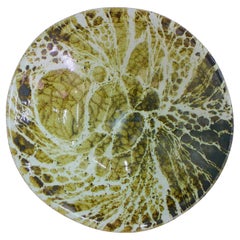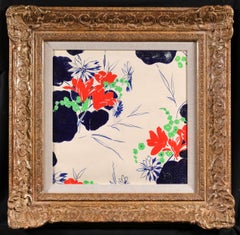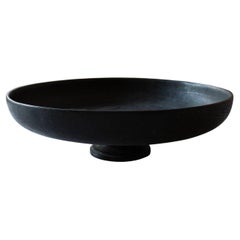James Tower Art
to
4
4
3
1
1
1945 Wartime Still Life Watercolor English Coveted Ceramic Artist And Teacher
By James Tower
Located in Sutton Poyntz, Dorset
James Tower.
English ( b.1919 - d.1988 ).
Still Life Of Cut Flowers In A Pottery Jug, 1945.
Watercolor & Ink.
Signed & Dated Lower Right.
Image size 13.2 inches x 10 inches ( 33.5c...
Category
Mid-20th Century Post-Impressionist James Tower Art
Materials
Paper, Ink, Watercolor
1940s Wartime Still Life Watercolor Painting By A Famous Ceramic Potter Sculptor
By James Tower
Located in Sutton Poyntz, Dorset
James Tower.
English ( b.1919 - d.1988 ).
Still Life Of Flowers In A Jug And A Plate Of Fruit.
Watercolor & Ink.
Image size 15.4 inches x 13 inches ( 39cm x 33cm ).
Frame size 22.2 ...
Category
Mid-20th Century Post-Impressionist James Tower Art
Materials
Paper, Ink, Watercolor
1944 Wartime Still Life Watercolor Painting Influential Ceramic Artist & Teacher
By James Tower
Located in Sutton Poyntz, Dorset
James Tower.
English ( b.1919 - d.1988 ).
Still Life Of Flowers In A Jug And A Bowl Of Apples, 1944.
Watercolor & Ink.
Signed & Dated Upper Right.
Image size 11.4 inches x 13.2 inch...
Category
Mid-20th Century Post-Impressionist James Tower Art
Materials
Paper, Ink, Watercolor
James Tower (British 1918-1988), Footed Bowl, 1980
By James Tower
Located in Wargrave, Berkshire
James Tower (British 1918-1988)
Footed Bowl, 1980
earthenware with green and white tin glaze
27.5cm diameter, 9cm high
incised signature and date to underside
Excellent condition, n...
Category
1980s English Modern Vintage James Tower Art
Materials
Earthenware
Related Items
Projet de Tissus - Fauvist Flowers Watercolor & Gouache by Raoul Dufy
By Raoul Dufy
Located in Marlow, Buckinghamshire
Botanical watercolour and gouache on paper circa 1920 by French fauvist painter Raoul Dufy. The work depicts flowers in red, blue and green. This work was executed by Dufy as a fabric design.
Dimensions:
Framed: 19.5"x19.5"
Unframed: 12"x12"
Provenance:
Private collection of works by Raoul Dufy for Bianchini Ferier
Bianchini Ferrier Collection - Christie's London - July 2001
SF Fall Show
Raoul Dufy was one of a family of nine children, including five sisters and a younger brother, Jean Dufy, also destined to become a painter. Their father was an accountant in the employ of a major company in Le Havre. The Dufy family was musically gifted: his father was an organist, as was his brother Léon, and his youngest brother Gaston was an accomplished flautist who later worked as a music critic in Paris. Raoul Dufy's studies were interrupted at the age of 14, when he had to contribute to the family income. He took a job with an importer of Brazilian coffee, but still found time from 1892 to attend evening courses in drawing and composition at the local college of fine arts under Charles Marie Lhullier, former teacher of Othon Friesz and Georges Braque. He spent his free time in museums, admiring the paintings of Eugène Boudin in Le Havre and The Justice of Trajan in Rouen. A municipal scholarship enabled him to leave for Paris in 1900, where he lodged initially with Othon Friesz. He was accepted by the École des Beaux-Arts, where he studied under Léon Bonnat, whose innate conservatism prompted Dufy to remark later that it was 'good to be at the Beaux-Arts providing one knew one could leave'.
And leave he did, four years later, embarking with friends and fellow students on the rounds of the major Paris galleries - Ambroise Vollard, Durand-Ruel, Eugène Blot and Berheim-Jeune. For Dufy and his contemporaries, Impressionism represented a rejection of sterile academism in favour of the open-air canvases of Manet, the light and bright colours of the Impressionists, and, beyond them, the daringly innovative work of Gauguin and Van Gogh, Seurat, Cézanne, Toulouse-Lautrec and others. Dufy was an out-and-out individualist, however, and was not tempted to imitate any of these artists. He produced, between 1935 and 1937, Fée Electricité (Spirit of Electricity), the emblem for the French utilities company Electricité de France (EDF).
Dufy visited the USA for the first time in 1937, as a member of the Carnegie Prize jury. In 1940, the outbreak of war (and his increasingly rheumatic condition) persuaded him to settle in Nice. When he eventually returned to Paris 10 years later, his rheumatism had become so debilitating that he immediately left for Boston to follow a course of pioneering anti-cortisone treatment. He continued working, however, spending time first in Harvard and then in New York City before moving to the drier climate of Tucson, Arizona. The cortisone treatment was by and large unsuccessful, although he did recover the use of his fingers. He returned to Paris in 1951 and decided to settle in Forcalquier, where the climate was more clement. Within a short time, however, he was wheelchair-bound. He died in Forcalquier in March 1953 and was buried in Cimiez.
Between 1895 and 1898, Raoul Dufy painted watercolours of landscapes near his native Le Havre and around Honfleur and Falaise. By the turn of the century, however, he was already painting certain subjects that were to become hallmarks of his work - flag-decked Parisian cityscapes, Normandy beaches teeming with visitors, regattas and the like, including one of his better-known early works, Landing Stage at Ste-Adresse. By 1905-1906 Friesz, Braque, Matisse, Derain, Vlaminck, Van Dongen and Rouault were described collectively as Fauves (the wild beasts). What they had in common was a desire to innovate, but they felt constrained nonetheless to meet formally to set out the guiding principles of what promised to be a new 'movement'. Dufy quickly established that those principles were acceptable; moreover, he was most impressed by one particular painting by Henri Matisse ( Luxury, Calm and Voluptuousness) which, to Dufy, embodied both novelty and a sense of artistic freedom. Dufy promptly aligned himself with the Fauves. Together with Albert Marquet in particular, he spent his time travelling the Normandy coast and painting views similar...
Category
1920s Fauvist James Tower Art
Materials
Paper, Watercolor, Gouache
$12,671
H 19.5 in W 19.5 in
Bronce Footed Bowl
Located in Rümmingen, BW
This bronze footed bowl has a simple yet striking presence. Its shallow form rests on a small pedestal, giving it a balanced, elevated look. The surface carries a natural patina, whi...
Category
1990s French Brutalist James Tower Art
Materials
Metal, Iron
Kosta Boda Limelight Bowl On Foot
By Göran Wärff
Located in Wilkes Barre, PA
Like all the items in the Limelight collection, this dish has the distinctive, textured base that optically reflects light. The small bowl on foot is great for everything from desser...
Category
21st Century and Contemporary Turkish James Tower Art
Materials
Crystal
1980's Memphis Era Large Footed Compote Ceramic bowl
By Ettore Sottsass
Located in San Diego, CA
Beautiful large glossy pink ceramic Memphis era ball footed compote, with turquoise ceramic bowls circa 1980's great condition.
Category
20th Century American Post-Modern James Tower Art
Materials
Ceramic
Vintage 5" Buccellati Sterling Silver Footed Bowl
By Buccellati
Located in Philadelphia, PA
A fine signed, designer Italian silver bowl.
By Gianmaria Buccellati.
In sterling silver.
With 4 applied feet and a scalloped body and rim.
Fully marked to the base.
Simply wond...
Category
20th Century Italian Modern James Tower Art
Materials
Sterling Silver
French Impressionist Tablescape Still Life Watercolour
Located in Cotignac, FR
French Impressionist watercolour on paper view of a colourful tablescape still life by Henri Clamen. The painting is not signed but was acquired form the atelier of the artist with o...
Category
Early 20th Century Impressionist James Tower Art
Materials
Paper, Ink, Watercolor
Underworld
Located in San Francisco, CA
Paula Valenzuela
Underworld, 2025
Alcohol ink and watercolor ink on Yupo paper
14 x 11 inches
This one-of-a-kind work on paper comes unframed. External, visible frame and glass in s...
Category
21st Century and Contemporary Contemporary James Tower Art
Materials
Paper, Ink, Watercolor
Vintage Regency Majolica Footed Bowl
Located in West Palm Beach, FL
A truly lovely example of Victorian-era ceramic artistry, this antique majolica footed compote is brimming with naturalistic charm. The piece features a beautifully scalloped dish, m...
Category
Late 19th Century British Art Nouveau Antique James Tower Art
Materials
Pottery
1980s Sculptural Glass Shell Footed Dish
By Blenko Glass
Located in Chula Vista, CA
Vintage Sculptural Glass Shell Dish footed.
In the style of Blenko Glass Company.
No label
6.75 w x 6.88 d x 2.68 h
Preowned original vintage condition
See all images please.
Category
Late 20th Century Modern James Tower Art
Materials
Art Glass
Brass Art Deco Footed Bowl
Located in West Palm Beach, FL
This stunning brass footed bowl, with its clean lines, is bifurcated at the neck by detailed filigree. It is lovely by itself, filled with decorative items or as a fruit bowl.
Category
Early 20th Century Art Deco James Tower Art
Materials
Brass
Ink and wash cartouche with a mirror, doves, and a drum
Located in Middletown, NY
A lovely and curious composition, circa 1780.
Ink and wash on tissue thin Japon paper, adhered to period cream laid paper, 5 1/4 x 3 3/8 inches (132 x 84 mm), the full sheet. With ...
Category
Late 18th Century French School James Tower Art
Materials
Ink, Handmade Paper, Watercolor
Tulips , White
Located in Zofingen, AG
In this piece, I poured vibrant emotions through acrylic, oil pastel, and colored pencil, blending expressionism, impressionism, and pop art to capture the delicate yet bold spirit o...
Category
2010s Pointillist James Tower Art
Materials
Oil Pastel, Acrylic, Archival Paper
James Tower art for sale on 1stDibs.
Find a wide variety of authentic James Tower art available for sale on 1stDibs. You can also browse by medium to find art by James Tower in ink, paint, paper and more. Much of the original work by this artist or collective was created during the 20th century and is mostly associated with the modern style. Not every interior allows for large James Tower art, so small editions measuring 17 inches across are available. James Tower art prices can differ depending upon medium, time period and other attributes. On 1stDibs, the price for these items starts at $3,233 and tops out at $3,622, while the average work can sell for $3,243.


